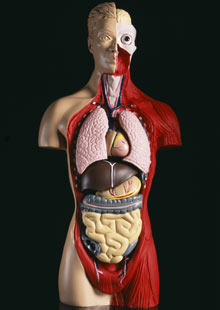 The department of anatomy provides rigorous training in dissecting cadavers and critically examines both ancient and modern views on anatomy. The surgical school of Ayurveda pioneered the technique of treating dead bodies in flowing water and exposing the underlying structures by scraping the skin using soft instruments to gain accurate knowledge of minute structures that make up the human body. This practice declined over the ages due to various factors and today Ayurvedic Anatomy needs to be supplemented with modern knowledge.
The department of anatomy provides rigorous training in dissecting cadavers and critically examines both ancient and modern views on anatomy. The surgical school of Ayurveda pioneered the technique of treating dead bodies in flowing water and exposing the underlying structures by scraping the skin using soft instruments to gain accurate knowledge of minute structures that make up the human body. This practice declined over the ages due to various factors and today Ayurvedic Anatomy needs to be supplemented with modern knowledge. A unique aspect of Rachana Shareeram in Ayurveda is the knowledge of the vital points or marmas, which have to be protected when performing surgical procedures and injury to which can lead to disastrous consequences including death. Knowledge of these vital points and techniques to manipulate them is essential to become proficient in therapeutic massage that stimulates prana and revitalises the body.




 This department deals with the study of normal physiology in human beings from both ancient and modern viewpoints with sufficient practical training. The corner stone of Ayurvedic physiology is the dosha-dhatu-mala siddhanta. This theory provides a holistic framework to understand how the body digests and metabolizes food into subtle forms of matter and energy to create and maintain a delicately balanced internal environment that is conducive to the preservation of the life process.
This department deals with the study of normal physiology in human beings from both ancient and modern viewpoints with sufficient practical training. The corner stone of Ayurvedic physiology is the dosha-dhatu-mala siddhanta. This theory provides a holistic framework to understand how the body digests and metabolizes food into subtle forms of matter and energy to create and maintain a delicately balanced internal environment that is conducive to the preservation of the life process. 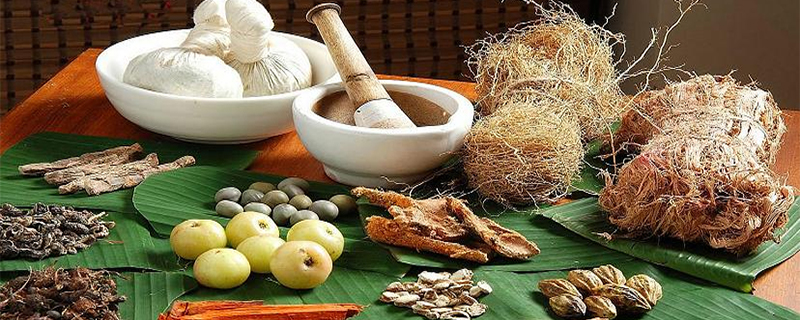 With the help of well equipped labs, this department imparts training in medicinal chemistry and preparation of highly potent medicines from minerals and metals. It also deals with the principles and practice of Ayurvedic Pharmacy with its varied pharmaceutical methods and dosage forms. Knowledge of Ayurvedic Pharmacy encompasses field identification of medicinal plants and other natural substances, collection and storage procedures of raw materials, preliminary processing of raw drugs, elaborate and sophisticated methods of pharmaceutical processing and preservation of prepared medicines.
With the help of well equipped labs, this department imparts training in medicinal chemistry and preparation of highly potent medicines from minerals and metals. It also deals with the principles and practice of Ayurvedic Pharmacy with its varied pharmaceutical methods and dosage forms. Knowledge of Ayurvedic Pharmacy encompasses field identification of medicinal plants and other natural substances, collection and storage procedures of raw materials, preliminary processing of raw drugs, elaborate and sophisticated methods of pharmaceutical processing and preservation of prepared medicines. 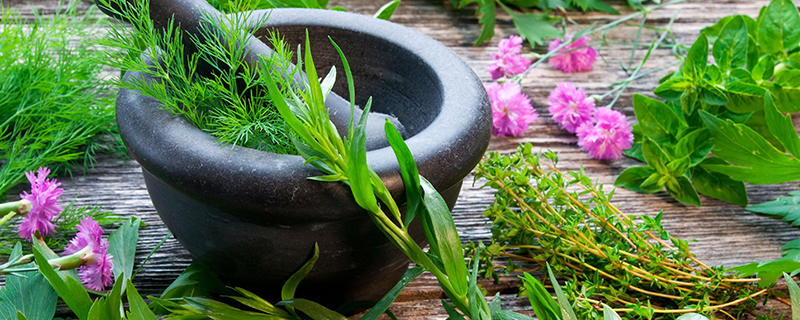 Deals with principles of Ayurvedic pharmacognosy and pharmacology with a special focus on identification of controversial drugs, adulterants and substitutes used in Ayurvedic practice. Ayurveda has developed a unique approach to understanding pharmacology of natural substances through meticulous analysis of taste, physico-chemical properties, potency and bio-transformation of the drug. Ayurveda traces the pathway of drug action right from the point of its ingestion through various stages of its digestion and metabolism to the point of its excretion from the body.
Deals with principles of Ayurvedic pharmacognosy and pharmacology with a special focus on identification of controversial drugs, adulterants and substitutes used in Ayurvedic practice. Ayurveda has developed a unique approach to understanding pharmacology of natural substances through meticulous analysis of taste, physico-chemical properties, potency and bio-transformation of the drug. Ayurveda traces the pathway of drug action right from the point of its ingestion through various stages of its digestion and metabolism to the point of its excretion from the body. 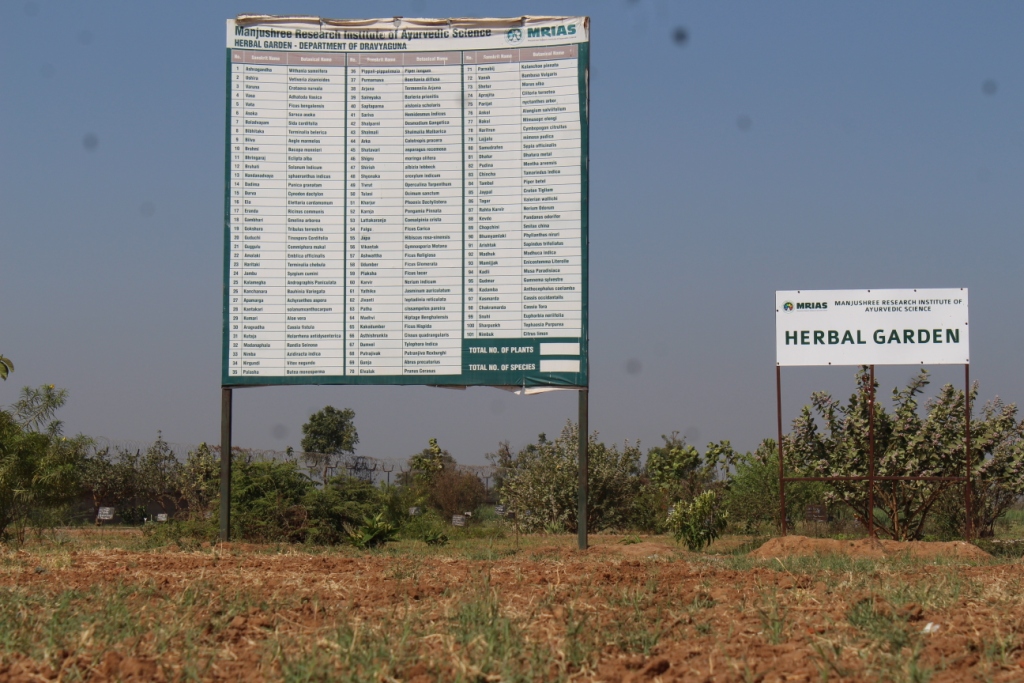

 Dravyaguna Shastra is the branch which deals with the properties action and therapeutic effects of various dravyas (Matter or Drugs). Dravyaguna as a whole revolves around leveraging the medicinal abilities of various biological substances available from plants and species. Well developed Herbal Garden is maintained in the campus so that students can be given practical information and identity of various medicinal plants and how to use them to prepare medicines. In total 161 different medicinal plant species are available in our herbal garden in different numbers.
Dravyaguna Shastra is the branch which deals with the properties action and therapeutic effects of various dravyas (Matter or Drugs). Dravyaguna as a whole revolves around leveraging the medicinal abilities of various biological substances available from plants and species. Well developed Herbal Garden is maintained in the campus so that students can be given practical information and identity of various medicinal plants and how to use them to prepare medicines. In total 161 different medicinal plant species are available in our herbal garden in different numbers.
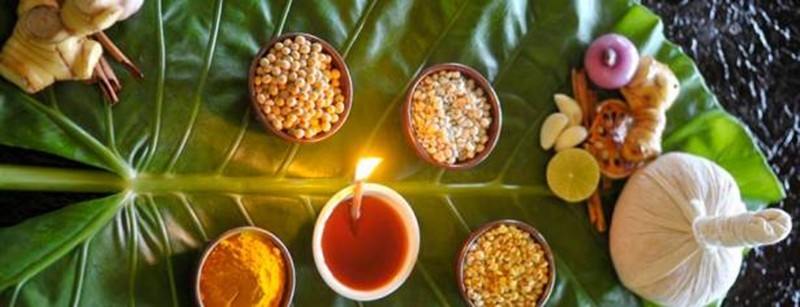 This department deals with nosology (classification of diseases) and techniques of diagnosis. Training is given in both ancient methods of diagnosis and relevant modern investigations. Ayurveda lays great stress on detecting diseases in the very early stages of development and has developed an elaborate system of subtle diagnostic techniques to identify imbalances in the body before they transform into complicated disease processes. Ayurveda gives equal emphasis on understanding origins of disease, the disease process and the external manifestations. It understands disease as a paradoxical combination of failure of physiological mechanisms and attempts by the body to restore normalcy.
This department deals with nosology (classification of diseases) and techniques of diagnosis. Training is given in both ancient methods of diagnosis and relevant modern investigations. Ayurveda lays great stress on detecting diseases in the very early stages of development and has developed an elaborate system of subtle diagnostic techniques to identify imbalances in the body before they transform into complicated disease processes. Ayurveda gives equal emphasis on understanding origins of disease, the disease process and the external manifestations. It understands disease as a paradoxical combination of failure of physiological mechanisms and attempts by the body to restore normalcy. 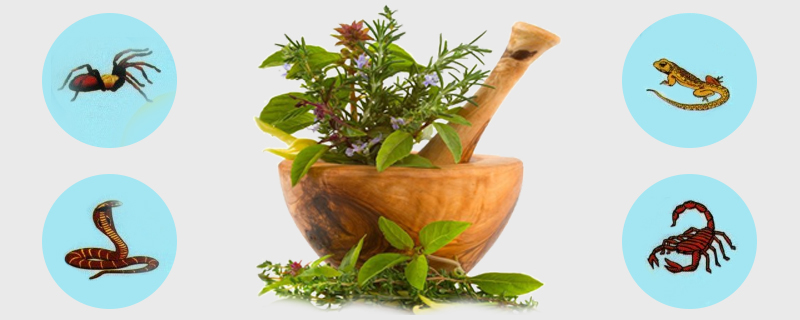 Imparts training in toxicology, jurisprudence and forensic medicine, which explores the causes of unnatural behavior and death. Ayurveda has nurtured and sustained a sophisticated system of toxicology that combats the effects of natural poisons posing long term or immediate threat to the continuity of the life process. This branch was so well developed in ancient India that the physicians of those days won the admiration of Alexander the Great, whose soldiers were miraculously cured of snake bites by native poison healers.
Imparts training in toxicology, jurisprudence and forensic medicine, which explores the causes of unnatural behavior and death. Ayurveda has nurtured and sustained a sophisticated system of toxicology that combats the effects of natural poisons posing long term or immediate threat to the continuity of the life process. This branch was so well developed in ancient India that the physicians of those days won the admiration of Alexander the Great, whose soldiers were miraculously cured of snake bites by native poison healers.  Imparts training in the division of General Medicine in Ayurveda. In ancient times, the practice of Ayurveda comprised of the two schools of medicine and surgery. Kayachikitsa, representing the school of medicine forms the basis for all other branches of Ayurvedic treatment and hence this department lays the foundation for shaping a skilled Ayurvedic physician. Panchakarma (fivefold technique to detoxify the system) as well as Rasayana (Rejuvenative medicine) and Vajikarana (Reproductive Health) come within the purview of this department.
Imparts training in the division of General Medicine in Ayurveda. In ancient times, the practice of Ayurveda comprised of the two schools of medicine and surgery. Kayachikitsa, representing the school of medicine forms the basis for all other branches of Ayurvedic treatment and hence this department lays the foundation for shaping a skilled Ayurvedic physician. Panchakarma (fivefold technique to detoxify the system) as well as Rasayana (Rejuvenative medicine) and Vajikarana (Reproductive Health) come within the purview of this department. 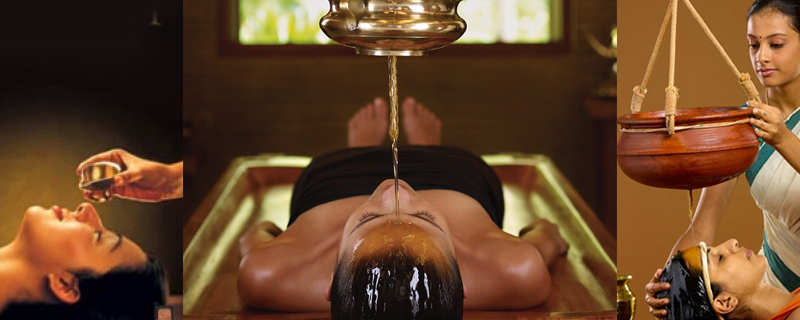 Deals with the Purification therapies of Ayurveda and provides a basic understanding of the principles of Shodhana. Panchakarma includes Vamana, Virechana, Nasya, Basti karma & Raktha Mokshan, using various kinds of Ayurvedic medicines. As far as the treatment methods are concerned Ayurveda has described the use of Shamana (Palliative treatment) and Shodhana (Bio-Purifaction methods - Panchakarma) methods.
Deals with the Purification therapies of Ayurveda and provides a basic understanding of the principles of Shodhana. Panchakarma includes Vamana, Virechana, Nasya, Basti karma & Raktha Mokshan, using various kinds of Ayurvedic medicines. As far as the treatment methods are concerned Ayurveda has described the use of Shamana (Palliative treatment) and Shodhana (Bio-Purifaction methods - Panchakarma) methods.  Deals with the branch of Ayurvedic surgery and provides a basic understanding of the principles of modern surgery. Bone setting, application of medicated thread (ksharasutra) for management of hemorrhoids and fistula in ano, application of leech as well as management of cuts and wounds are the areas of strength in Ayurvedic surgery. Though modern surgery has advanced in leaps and bounds, the Ayurvedic principles of pre and post operative care still has relevance today. Judicious application of Ayurvedic principles of surgical care can prevent complications and facilitate speedy recovery from surgical interventions. Ayurveda has historically made foundational contributions to the development of the branch of surgery.
Deals with the branch of Ayurvedic surgery and provides a basic understanding of the principles of modern surgery. Bone setting, application of medicated thread (ksharasutra) for management of hemorrhoids and fistula in ano, application of leech as well as management of cuts and wounds are the areas of strength in Ayurvedic surgery. Though modern surgery has advanced in leaps and bounds, the Ayurvedic principles of pre and post operative care still has relevance today. Judicious application of Ayurvedic principles of surgical care can prevent complications and facilitate speedy recovery from surgical interventions. Ayurveda has historically made foundational contributions to the development of the branch of surgery.  Imparts training in areas of specialization like ENT, Ophthalmology, Dentistry and diseases of the head. Special training is given on management of certain eye diseases, conditions like sinusitis, migraine and such other conditions for which Ayurvedic treatment is effective. It was in the field of Ayurveda that the specializations of ENT, Ophthalmology and Dentistry first developed.
Imparts training in areas of specialization like ENT, Ophthalmology, Dentistry and diseases of the head. Special training is given on management of certain eye diseases, conditions like sinusitis, migraine and such other conditions for which Ayurvedic treatment is effective. It was in the field of Ayurveda that the specializations of ENT, Ophthalmology and Dentistry first developed.  Imparts training in Ayurvedic Gynecology, Obstetrics and Pediatrics. Gynecology deals with menstrual disorders, diseases of the female genital tract and venereal diseases. Ayurveda advises a special regimen for care of the pregnant woman. It also lays down certain guidelines to ensure the birth of a healthy child. Obstetrics deals with conditions related to maternity as well as normal and abnormal delivery.
Imparts training in Ayurvedic Gynecology, Obstetrics and Pediatrics. Gynecology deals with menstrual disorders, diseases of the female genital tract and venereal diseases. Ayurveda advises a special regimen for care of the pregnant woman. It also lays down certain guidelines to ensure the birth of a healthy child. Obstetrics deals with conditions related to maternity as well as normal and abnormal delivery. 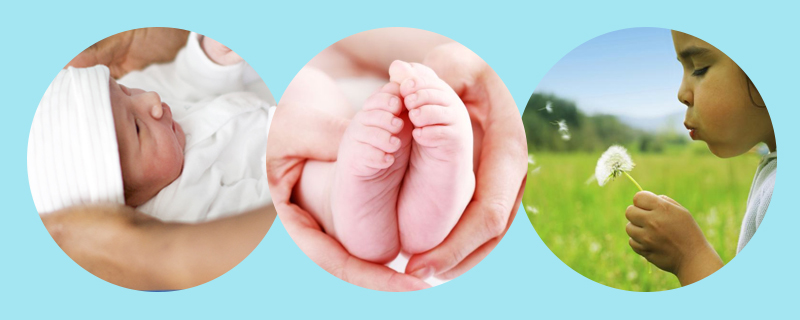 Ayurveda offers special treatment modalities for post natal care of the mother. Pediatrics deals with care of the new born as well as diseases affecting children. Traditions of Ayurvedic pediatrics’ are still alive in India. In ancient times, Ayurvedic pediatrics was a separate school of medicine, although it was not as prominent as the schools of medicine and surgery. The Kashyapa Samhita is a classical text on Pediatrics which has been preserved in a mutilated form and is more than 2000 years old.
Ayurveda offers special treatment modalities for post natal care of the mother. Pediatrics deals with care of the new born as well as diseases affecting children. Traditions of Ayurvedic pediatrics’ are still alive in India. In ancient times, Ayurvedic pediatrics was a separate school of medicine, although it was not as prominent as the schools of medicine and surgery. The Kashyapa Samhita is a classical text on Pediatrics which has been preserved in a mutilated form and is more than 2000 years old. 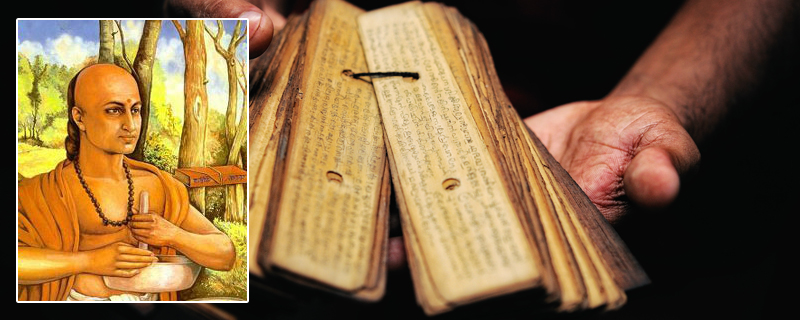 This department deals with the teaching of subjects that are foundational for the study of Ayurveda like Sanskrit, basic principles, classical Ayurvedic texts, history of Ayurveda and epistemology. Proficiency in Sanskrit is indispensible to properly understand the import of classical Ayurvedic writings. This has to be further substantiated by a thorough grounding in the classical knowledge systems of India including both the theistic and atheistic schools.
This department deals with the teaching of subjects that are foundational for the study of Ayurveda like Sanskrit, basic principles, classical Ayurvedic texts, history of Ayurveda and epistemology. Proficiency in Sanskrit is indispensible to properly understand the import of classical Ayurvedic writings. This has to be further substantiated by a thorough grounding in the classical knowledge systems of India including both the theistic and atheistic schools.  Imparts training on the principles and practice of Social and Preventative Medicine at both the personal and communal levels. Promotion of positive health is dealt with from the Ayurvedic viewpoint. Naturopathy and Yoga also come under the purview of this department. Social and Preventative Medicine in Ayurveda deals with elaborate guidelines and regimens for maintaining and promoting health of the individual and the community as a whole. Regulation of life style, diet and behavior on the basis of diurnal, seasonal and geographical variations as well as the constitution of the individual is an important component of preventive medicine in Ayurveda.
Imparts training on the principles and practice of Social and Preventative Medicine at both the personal and communal levels. Promotion of positive health is dealt with from the Ayurvedic viewpoint. Naturopathy and Yoga also come under the purview of this department. Social and Preventative Medicine in Ayurveda deals with elaborate guidelines and regimens for maintaining and promoting health of the individual and the community as a whole. Regulation of life style, diet and behavior on the basis of diurnal, seasonal and geographical variations as well as the constitution of the individual is an important component of preventive medicine in Ayurveda.